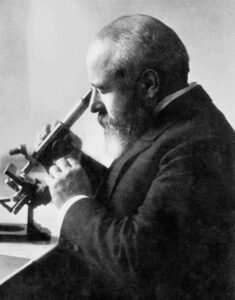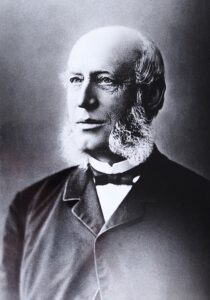The history of the active ingredient Ichthyol® began 200 million years ago and is still relevant. Products with Ichthyol® remain current today, for example as an alternative to antibiotics and cortisone. For around 150 years, the Ichthyol-Gesellschaft has been using the “power from the mountain” to develop effective and sustainable medicines.
From prehistory to the modern age
200 million years ago
At the time of the dinosaurs, the area of today’s Jura Mountains and the Tyrolean Alps was covered by a tropical shallow sea, the Tethys Primordial Sea. Over 50 million years, animal and plant matter were deposited on the seabed and covered by sediment layers consisting of shell and coral particles. Under the resulting high pressure, a limestone interspersed with organic substances formed – the so-called “oil shale rock”. Traces of life at this time can still be found today in the Jura and Alpine rocks -such as in the form of fossil fish, plants or dinosaur footprints.
10 to 2 million years ago
The African continental plate moved northwards and caused the folding of the Alps and the flat sedimentary layers of the Jura Mountains with tremendous force. The oil shale layers were also being pushed upwards – in the Tyrolean Seefeld -up to an altitude of 1800 metres.
Antiquity
Famous physicians of antiquity, such as Pliny and Galen, mention in their writings a versatile remedy obtained from “gagate stone” and “oil stone”.
1537
Legendary Tyrsen blood
Around 1500, doctors at the princely court in Innbruck were already familiar with the Seefeld slate oil as a remedy under the name “Tyrsen blood”. According to legend, the brown-red oil slate stones are soaked in the blood of the giant Tyrsus, who was slain by the giant Haymon in a brutal duel. A fresco from 1537 on the wall of a house in Leithen still tells of this legend.
The fresco depicting the battle of the giants has been painted over several times throughout history and was finally restored on behalf of the Ichthyol Company. The text reads: In this house the peasant giant Tyrsus was born in the 9th century. The knightly giant Haymon also lived there at that time. The two giants were always at odds and finally Tyrsus was killed by Haymon in a duel. Haymon was stricken with remorse and founded the Wilten monastery as atonement, where he entered as a penitent. Tyrsus’ last words as he fled over the mountains were: “Go forth, innocent blood, and do good for animals and men!
1879

In 1879 the chemist Rudolf Schröter came across oil shale rock during excursions in the Tyrolean Karwendel Mountains, from which inhabitants of the Seefeld area produced a dark oil with a sulphur-like smell. This ” Dirschenöl” had been known for a long time as a remedy for humans and animals. Schröter’s interest was aroused – he was convinced that medicines could be developed from this oil. His enthusiasm was rewarded- the process he invented to convert the oil into a water-soluble form made it possible for the first time to use it in pharmaceutical ointments and creams.
Inspired by the primeval fossils in the rock, Schröter gave the water-soluble oil the name Ichthyol® – derived from the Greek “ichthys” for fish and the Latin “oleum” for oil.
1882

The famous dermatologist Prof. Dr. Paul Gerson Unna from Hamburg published his first therapeutic successes with Ichthyol® in the treatment of skin diseases¹. He enthusiastically described the anti-inflammatory, pain, and itch-relieving properties of the dark active ingredient.
1: Unna, P.G., 1882. IV. Ichthyol: Monatshefte für Praktische Dermatologie. S. 328-333.
1882

1882 saw the granting of the patent to produce Ichthyol®.
1884


The merchants Heinrich Cordes and Gustav Hermanni founded the Ichthyol company Cordes, Hermanni & Co. in Hamburg together with the chemist Rudolf Schröter. The marketing of dark Ichthyol® as an active ingredient for use in medicines begins.
1925

The black Ichtholan® drawing ointments are introduced to the market. Ichtholan® is still the best-selling drawing ointment for the treatment of superficial and deep skin inflammations, such as abscesses². The black ointments are also used in the treatment of orthopaedic diseases such as arthritis and sports injuries.
2: Absatz Apotheken, Insight Health, MAT 06/22
Ichthotop®
Wirkstoff: Natriumbituminosulfonat, hell. Anwendungsgebiete: Ichthotop®, Gel wird angewendet bei lokalisierten, kleinflächigen bakteriell bedingten Hauterkrankungen, bei denen Natriumbituminosulfonat angezeigt ist (z.B. Impetigo). Enthält Propylenglycol. Zu Risiken und Nebenwirkungen lesen Sie die Packungsbeilage und fragen Sie Ihre Ärztin, Ihren Arzt oder in Ihrer Apotheke. Ichthyol-Gesellschaft Cordes, Hermanni & Co. (GmbH & Co.) KG, 22335 Hamburg
1933
In 1933 a further active ingredient is developed: light Ichthyol®. Dark Ichthyol® is used for deeper skin inflammations such as abscesses and orthopaedic diseases due to its penetrating action. The Ichthyol® pale version is particularly well suited for the treatment of superficial skin diseases such as acne, atopic dermatitis, psoriasis and wounds. Over following years, Ichthyol-Gesellschaft developed various medicinal products for the treatment of skin diseases.
21.
century
To this day, Ichthyol-Gesellschaft remains 100 % family-owned. All production steps – from the extraction of the shale to the production of the medicinal products, product formulations and raw material preparation – are in the hands of the company. Around 100 employees work at the three sites in Hamburg, Orbagnoux (France) and Seefeld (Tyrol/Austria). The oil shale is extracted in the French Jura Mountains in a company-owned mine. The responsible treatment of nature has always been our top priority. The oil produced in France is processed into the Ichthyol® active ingredients at the company’s Tyrolean site. The portfolio includes 30 finished medicinal products with and without Ichthyol® active ingredients, as well as 15 formulation bases. Our products are manufactured, marketed, and distributed by the company headquarters in Hamburg. In 2021, 1.7 million packs were delivered. In addition to manufacturing its own products, Ichthyol Gesellschaft supplies industrial customers with Ichthyol® raw materials that are used internationally in the manufacturing of medicinal products and cosmetics.
Future
The Mars mission
“Was there life on Mars?” The next Mars mission by the European Space Agency ESA “ExoMars” is under preparation. One objective is to find out whether there were traces of life on the red planet or even primordial oceans similar to those on Earth. To answer these questions, the research team has examined the oil shale rock from the Ichthyol® mine with state-of-the-art geochemical analyses and will use it as a comparison for studies on rock material from Mars. The launch planned for September 2022 has currently been postponed due to the involvement of the Russian space agency; a new launch date has not yet been communicated.
